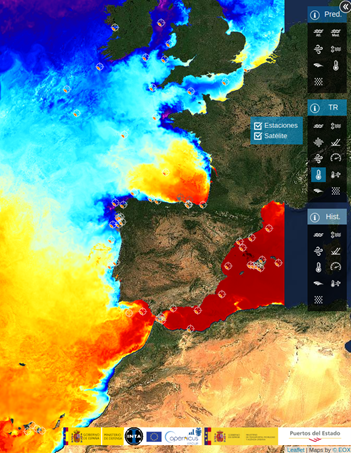
The temperature of the Mediterranean exceeded 31°C this summer
- The Dragonera buoy (Balearic Islands) recorded the historical maximum of the entire Puertos del Estado buoy network this summer.
- In the Atlantic, without reaching historical records, maximum values associated with July and August have been exceeded in the Cantabrian Sea and the Canary Islands.
September 19, 2022 (Public Body Puertos del Estado). After the months of July and August, marked by persistent high temperatures in our seas, record values have been recorded in various buoys of the Puertos del Estado measurement networks. These records have been reviewed, confirming that the buoys of Ceuta, Cabo de Gata, Cabo de Palos, Valencia, Tarragona Exterior, and Dragonera have exceeded the maximum temperatures measured since they started operating. Additionally, the 31.36 ºC recorded by the Dragonera buoy in August is the absolute record of the Puertos del Estado networks since there are records.
Although this warming episode has been more pronounced in the Mediterranean, where several absolute records have been recorded, it has also been notable in the Cantabrian Sea and the Canary Islands. In these areas, without reaching values of historical records, maximums associated with the months of July and August have been exceeded in various stations.
MEDITERRANEAN SEA
This episode of persistent high water temperatures during the months of June, July, and August, as expected, has been more pronounced in the Mediterranean, where the highest values have been reached in the measurement stations.
The Dragonera buoy, operational since the summer of 2009, which already held the historical record of water temperature since 2018 when it recorded 31.27ºC, has again surpassed this mark on two occasions. It measured 31.34 ºC on August 11 at 3:00 PM UTC and later reached 31.36 ºC on August 24 at 3:00 PM UTC, which remain the highest recorded water temperature obtained by the Puertos del Estado measurement networks.
High temperatures in the Mediterranean have also set records in the individual series of several buoys. The Valencia buoy, operational since 2005, measured 29.94 ºC on August 11 at 6:00 PM UTC, surpassing the value of its previous record of 28.65 ºC obtained in August 2015. Nearby, the Tarragona Exterior buoy, in operation since 2004, recorded 29.77 ºC on August 11 at 6:00 PM UTC, above its previous maximum of 29.56 ºC from August 2018. Further south, both in the Cabo de Palos buoy and the Cabo de Gata buoy, with water temperature data since 2006 and 2001 respectively, records were set in July, reaching 29.37 ºC on July 28 at 3:00 PM UTC in the first and 27.93 ºC on July 25 at 5:00 PM UTC in the second.
Among the buoys located closer to the coast, the Ceuta buoy, with temperature data since 2014, also set its historical maximum on August 6 at 5:00 PM UTC, where 24.6 ºC were measured, two degrees higher than its previous record of 22.6 ºC recorded in August 2016.
ATLANTIC COAST
On the Atlantic coast, water temperature values have not been as high, and global historical records have not been recorded in the Puertos del Estado buoys, although values associated with the month of July have been exceeded in several of them, located both in the Cantabrian Sea and the Canary Islands.
In the Cantabrian Sea, the coastal buoy of Bilbao, operational since 2004, marked its highest record associated with the month of July on the 14th by measuring 25.6 ºC at 2:00 PM UTC. On the same day, the Bilbao-Vizcaya buoy, with data since 2006 and moored in open waters, measured 24.68 ºC at 5:00 PM UTC. In this case, the value reached constitutes the highest record obtained by that buoy for the months of July and also its second-highest historical record, only surpassed by the 24.95 ºC measured in August 2018.
The coastal buoy of Pasaia II, moored at the beginning of 2022, does not have a representative enough history to speak of records, but it is worth noting that on July 18 at 2:00 PM UTC, it recorded 28 ºC.
In the Canary Islands, three of the four buoys that Puertos del Estado has in operation exceeded their values associated with the month of July. The buoy of Tenerife Sur and that of Gran Canaria, both with water temperature sensors since 2001, measured 24.66 ºC on the 13th and 23.32 ºC on the 27th, respectively. On the other hand, the coastal buoy of Las Palmas Este, with water temperature data since 2014, reached 23.5 ºC on the 26th and 27th of July. In all cases, the values do not reach the respective historical maximums, which in this area usually occur in the month of September.
PUERTOS DEL ESTADO MEASUREMENT NETWORKS
Puertos del Estado has an External Buoy Network (or deep-water buoys) composed of 15 measurement positions, a Coastal Buoy Network with 12 measurement positions, a network of 46 Tide Gauges along the Spanish coast, and a high-frequency radar network with 9 stations. All information is received in real-time at Puertos del Estado, which is responsible for its management.
Puertos del Estado obtains records of the water temperature from our coasts through the two buoy networks, the Coastal Network, and the External Network. External Network buoys are characterized by being anchored far from the coastline at great depths, between 200 and 1,800 meters, and usually have a large size, up to 3 meters in diameter and 7 meters in length, with satellite transmission. Coastal Network buoys are located near ports, at less than 100 meters depth, and transmit measurements to the coast via radio and GPRS.
Although the measurement frequency of the buoys is one data per hour, this does not mean that the provided parameters are being measured throughout the entire hour. In the case of water temperature, the measurement is instantaneous, and it is assumed that this value represents the temperature for that hour.

